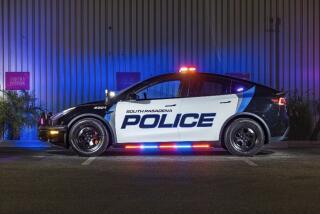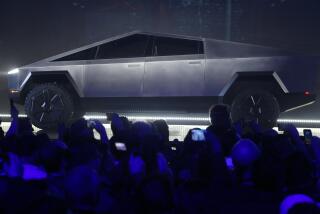Battle Heats Up for Sales of Police Cars
- Share via
Two big guns in the auto industry are about to challenge each other in the lucrative police car market.
Ford Motor Co. is the top dog now. Its police model Crown Victoria-Interceptor, with a 240-horsepower V-8 engine, accounts for about 80% of all patrol car sales nationwide.
But DaimlerChrysler is building powerful rear-wheel-drive cars with V-8 engines again -- the kind preferred by police agencies -- and wants back into the game. Its Dodge brand late this year will launch a police version of its new Magnum sport wagon. And rumors swirl about a police version of the upcoming Dodge Charger performance sedan.
There’s decent money in selling cop cars. Police agencies nationally purchase about 55,000 patrol cars a year. Ford’s Crown Victoria accounts for about 45,000 of them. The Ford sedan is favored by, among others, the Los Angeles Police Department, the California Highway Patrol and the Los Angeles County Sheriff’s Department.
The company makes about $750 in profit per car, according to one Ford executive. Those sales add about $34 million to the bottom line each year. (Ford on Tuesday posted second-quarter earnings of $1.2 billion.) But the stakes are higher than just police sales. A car that stands up to police work tends to appeal to other large-volume buyers: taxi companies, limousine services and business fleets.
Assorted General Motors Corp. and Chrysler vehicles make up the rest of the police car mix.
The spacious Ford Crown Vic, however, is the only car certified for police work by two national testing agencies: the L.A. County Sheriff’s Department and the Michigan State Police.
At least that’s the case right now. Next month, the Dodge Magnum will undergo testing by L.A. sheriff’s officials, and testing in Michigan will be performed in September. The tests rate cars for top speed, acceleration, braking, handling and the all-important ergonomics: how well police officers and their equipment fit inside.
For its part, Ford doesn’t intend to let Dodge race off with its police business. “It is not something we will willingly give up,” Ford President Nick Scheele said.
The new Dodge is a so-called unibody car in which the frame is an integral part of the body, rather than a separate steel assembly. Unibody vehicles reduce rattles and squeaks -- but, as Scheele was quick to point out, typically don’t hold up as well to extremely rough use as body-on-frame models. “So far,” he said, “no frameless vehicle has been able” to meet law enforcement’s reliability requirements.
Nonetheless, the competition promises to be stiff. Although the Dodge Magnum is a station wagon, the tough-looking vehicle with a Mercedes-Benz-designed drivetrain was designed to handle like a car. The Magnum’s top-end 5.7-liter, V-8 engine delivers 340 horsepower, enough to run down most fleeing miscreants.
It can also run away from the Crown Vic. The new Dodge covers 0 to 60 mph in about 6.3 seconds, versus 8.3 for the Ford. And with police being asked to carry more gear to help with anti-terrorism security activities, the wagon’s additional storage space could be a plus.
Ford has another vulnerability as well: The Crown Victoria has been involved in a number of high-profile gas tank fires, and several police agencies have sued the company over its gas tank design. To deal with the problem, Ford has developed an aircraft-type fire suppression system that it will offer next year on police models. “That will be a big selling point,” Scheele said.
Dodge once dominated the police car market but stopped making police vehicles 16 years ago when it dropped rear-wheel-drive cars in pursuit of better fuel economy.
“My hope is that we can recapture the glory days,” said Gerry Appie, fleet engineering manager at Dodge. The company, he added, expects police use of the Magnum to “have a halo effect” that will boost regular retail sales of the vehicle.
It seems to work for Ford. Although there’s not a huge market for big rear-wheel-drive sedans in the U.S. these days, the company manages to consistently sell about 80,000 Crown Victorias each year, making it the 10th-bestselling passenger vehicle of Ford Motor’s 22 domestic models.
“Everybody is looking at products that could meet the requirements of the police market” and benefit from the cross-marketing, GM spokesman Chuck Harrington said. He hinted of plans to build a new GM-brand police vehicle. GM’s Chevrolet Caprice, a whalelike sedan with a powerful V-8 engine, was the most sought-after police car from 1989 until Chevy halted production in 1996.
Appie said Dodge would aim the 2005-model-year police Magnum at the special service segment, such as canine patrols and accident investigation teams. The vehicle’s floor-mounted shifter interferes with installation of vital communications equipment needed in patrol cars and can’t be relocated to the steering column until the next model year. The 2006 model will be suitable for all phases of police work, Appie said.
The police Magnum will have upgraded brakes, suspensions, tires and Dodge’s new Hemi V-8, a powerful engine with roots in the heyday of drag racing and American muscle cars. The engine uses hemispherical combustion chambers that increase power.
Police agencies prefer rear-wheel-drive cars because they are larger and cheaper to maintain and repair than front-wheel-drive models.
“Most police vehicle crashes involve front-end damage,” said Cmdr. Robert Sedita, head of the L.A. County Sheriff’s Department’s technical services division. “If you wreck the front of a front-wheel-drive car, you probably have to replace most of the drivetrain, as well as the radiator and grille and bumper. With a rear-wheel-drive, you don’t have that expense.”
Even police cars that don’t get smashed up have relatively short lives. Most departments limit their cars to 100,000 miles because they take such a beating.
The Sheriff’s Department says its cruisers last three to five years, with plenty of low-speed city driving and idling broken by quick bursts of acceleration. It’s the roughest way to drive a car.
* (BEGIN TEXT OF INFOBOX)
Tale of the tape
Ford’s Crown Victoria-Interceptor accounts for about 80% of all patrol sales but will soon be challenged by a police version of the Dodge Magnum sport wagon.
Ford Crown Dodge Magnum Victoria (Police) Interceptor Vehicle type Large sedan Large sport wagon Engine 4.6-liter, V-8 5.7 liter, V8 Horsepower 240 340 Transmission 5-speed 5-speed automatic automatic 0-60 acceleration 8.3 seconds 6.3 seconds* Police officers in front 2 2 Front legroom 42.5 inches 41.8 inches Suspects in the back 2 2 Rear legroom 39.6 inches 40.2 inches Length 212 inches 197.7 inches Width 77.3 inches 74.1 inches Wheelbase 114.7 inches 120 inches Vehicle weight* 4,057 pounds 4,142 pounds Fuel economy (city/highway)* 18/25 mpg 17/24 mpg
*Without police equipment
Sources: Ford Motor, DaimlerChrysler, L.A. County SheriffÕs Department, Edmunds.com






